I had the pleasure of attending a fantastic wine event at the Santa Cruz Museum of Art and History last fall. Dubbed “Rootstock,” this first-of-its-kind event focused on the history and art of winemaking in the Santa Cruz Mountains American Viticultural Appellation (AVA) and attempted to answer a fundamental question: what makes this region special for wine?
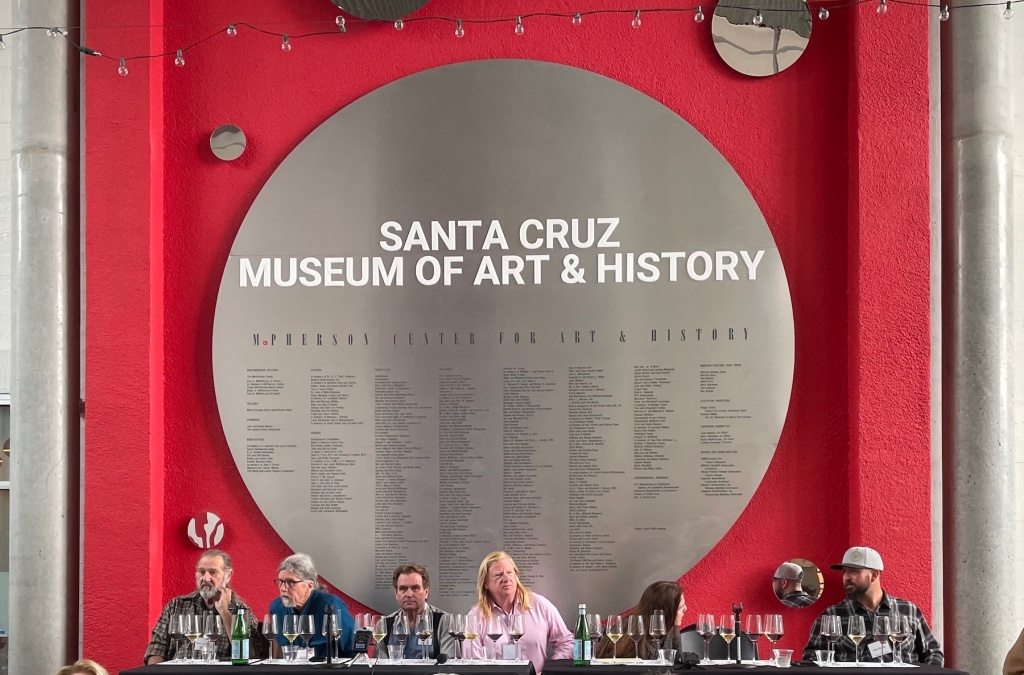
Dave Bennion, David Bruce, Ken Burnap, Paul Draper, Agoston Haraszthy, John Jarvis, Charles LeFranc, Paul Masson, Henry Mel, Emil Meyer, Vincent Picchetti, Osea Perone, Martin Ray, Emmett Rixford, John Stewart. These are just a few of the trailblazing wine visionaries who believed that world-class wine could be grown and made in the Santa Cruz Mountains. The current generation of Santa Cruz Mountains winemakers and winegrowers continue to strive to uphold the vision of unsurpassed quality and uniqueness first seen in this region by those wine pioneers that first planted grapes and made wine here over 150 years ago.
The Santa Cruz Mountains AVA was formed in 1981, thanks to the tireless, persistent, and passionate efforts of a few key people, including Ken Burnap (Santa Cruz Mountain Vineyard), David Bennion (Ridge Vineyards), Dan Gehrs (Congress Springs Vineyard), Nat and Jan Sherrill (Sherrill Cellars), Dexter and Valerie Ahlgren (Ahlgren Vineyards), among others. It was the first appellation in the USA to be defined by its elevation, and the first to be defined by geographic and climatic boundaries. The rules state that, for wine to be labeled as Santa Cruz Mountains AVA, the grapes must come from vineyards at 400 feet minimum on the coastal side of the mountains and 800 feet minimum on the valley side. In addition, unlike surrounding appellations, the Santa Cruz Mountains AVA is not part of the very large (and less specific) regional Central Coast AVA, which stretches from Santa Clara Valley down south to Santa Barbara County.
Due to the rich and extensive material covered during this event, this is a long article which I’ve divided into three parts. Click on the highlighted text to jump to that section. The first part covers the panel discussion, the heart of the event. I recorded the panel and have provided essentially an annotated transcript of it, with lots of fascinating anecdotes and histories from the distinguished speakers on the panel. The second part covers the tastings, both the seated flight paired with the panel discussion and the walk-around tasting throughout the museum afterwards. And the third part offers a list of resources for further reading on the fascinating and long history of winegrowing and winemaking in the Santa Cruz Mountains.
Panel Discussion: “What brings us together is our faults.” – Prudy Foxx
The event started with an esteemed panel of six current-generation local winemakers and growers on the history of Santa Cruz winegrowing, accompanied by a tasting flight of six exceptional wines, each representing the panelists’ wineries or vineyards. The panel was a veritable who’s-who in our current local wine industry with John Locke of Birichino Winery moderating from the center of the long table with aplomb, wit, and flair. This panel discussion was the highlight of the day!
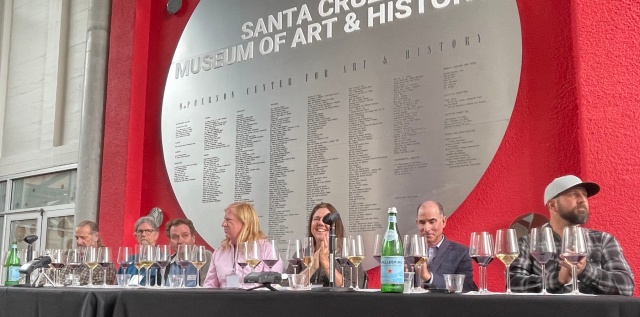
To start, the panelists each introduced themselves and a small bit of their own history.
Kyle Theriot, Director of Vineyard Operations at Ridge Vineyards Monte Bello estate, has been with Ridge in Cupertino for 11 years. He was born and raised in Aptos and grew up on a family apple farm.
John Bargetto, Director of Winemaking at Bargetto Winery, is the fourth-generation winemaker at Bargetto, which was established in Soquel over 90 years ago. John is the winegrower in the family and farms the Regan Vineyard in Corralitos under the direction of Prudy Foxx.
Prudy Foxx, proprietor/viticulturist at Foxx Viticulture, is considered our local vine whisperer. “I always like to say that what brings us together here in Santa Cruz is our faults,” she said, a reference to the geological upheavals over the millenia that formed the mountains and unique microclimates and soil structures here. Prudy has been in the wine business over 40 years and is viticulture consultant for over 20 different vineyards in the Santa Cruz Mountains AVA. No one knows the diversity of our terroir as well as she does. After graduating college in Washington state, Prudy went into the wine business and became (in her words) “obsessed with the idea that wine starts in the vineyard.”
Prudy introduced other women whom she had invited to the event that are also part of our history: Val Ahlgren of Ahlgren Vineyards (started in 1976 with her husband Dexter and now closed) and Pam Storrs of Storrs Winery (started in 1983 with her husband Steve Storrs).
Jeffrey Patterson was next, owner/winemaker at Mount Eden Vineyards, which is celebrating its 50th year in business. Before the vineyard was known as Mount Eden, it was Martin Ray, named after the one of the most influential people making premium wine in the Santa Cruz Mountains back in the 1940s. Mentored by Paul Masson, who owned vineyard property and a winery next door focused on traditional method “champagne,” Martin Ray planted Chardonnay, Pinot Noir, and Cabernet Sauvignon on his estate. The estate Chardonnay has produced clonal material known as “the Mount Eden clone” for hundreds of acres of Chardonnay across all of California. Says Patterson, “These vines have the longest lineage of any Chardonnay in California.” Patterson has been at Mount Eden for over 40 years.
Jeff Emery, owner/winemaker at Santa Cruz Mountain Vineyard, has a direct link to Santa Cruz Mountains winegrowing history, having apprenticed for Ken Burnap, one of the people who delineated and applied for AVA status for the region. Santa Cruz Mountain Vineyard was founded in 1975 by Burnap who “thought this would be the best place to grow Pinot Noir in the US,” says Emery. Jeff joined as an apprentice in 1979 and never left, working with Burnap for 25 years and eventually taking over the business. With his 44th season at Santa Cruz Mountain Vineyard just complete, Emery reflected on the quality and longevity of his wines. “We are known for our Pinots living for decades.”
Barry Jackson, owner/winemaker at Equinox Winery, makes traditional method sparkling wines in Santa Cruz. Barry is a first-generation winemaker, having started his first vintage in 1989, picking grapes five days before the Loma Prieta earthquake of 10/17/1989. He reflected on the legacy of Frenchman Paul Masson, who brought notoriety to the Santa Cruz Mountains with his Pinot Noir-based “champagne”.
Other local wine industry people that were not in attendance but who are without question important to the history of Santa Cruz Mountains AVA: Jerold O’Brien, owner/winemaker at Silver Mountain Vineyards, Randall Grahm of Bonny Doon Vineyard and Popelouchum, Ryan and Jim Beauregard of Beauregard Vineyards (who established the Ben Lomond Mountain sub-AVA within the Santa Cruz Mountains AVA), and others.
After each of the panelists introduced themselves and their role in the local winemaking scene, John Locke posed questions to them.
The first question was to Jeffrey Patterson: “Jeffrey, admit it. Santa Cruz is a small town. We’re all sort of provincial country bumpkins. The Santa Cruz Mountains isn’t really anything special, is it? Or is there actually something meritorious about this appellation that we all work in?”
Patterson responded, “Santa Cruz Mountains is unique because it’s an appellation based on elevation. I don’t believe there’s any other appellation in America that’s based on that specific attribute. The soils are primary soils, very poor in fertility, they force the vines to go deep for water and nutrients. Yields are small, no one has any water, the vineyards are miles and miles apart from each other, the appellation in general is all by itself; it’s not in the Central Coast [larger AVA] and the wines don’t taste like it either. It’s not in the North Coast [even larger AVA] and doesn’t taste like Napa or Sonoma. The Santa Cruz Mountains appellation is huge in square miles, but very, very small in bottle production.”
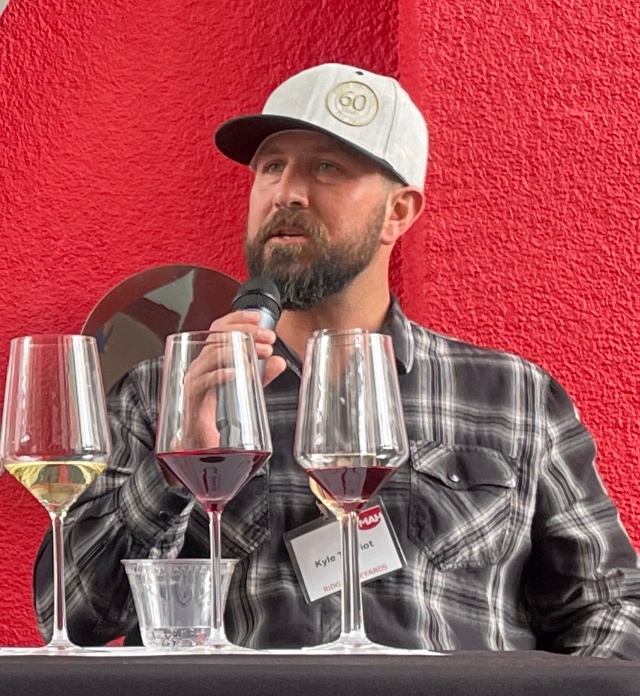
Locke next asked Theriot, the youngest person on the panel and relatively new to working in the appellation, if when he’s working in the vineyard at Ridge Monte Bello, “Are you thinking of the future, or are you thinking about 50 years of this legacy that you have to serve?”
Kyle replied that he “definitely has a sense of awe on a day-to-day basis.” He continued, “We have a unified vision that Ridge Monte Bello won’t be the same wine year after year. Mountain fruit, minerality, that is special and unique to Monte Bello. My goal is to create the best wine we can with any given vintage with the same style in mind of what Monte Bello has been since 1962.”
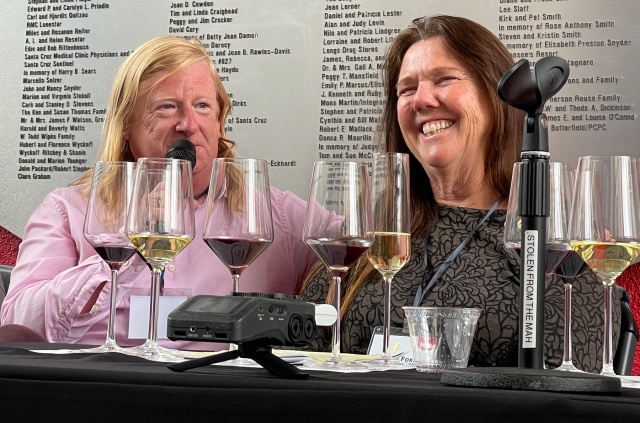
Next up, Prudy Foxx responded to the following question: “Is Santa Cruz Mountains AVA distinctive enough that we can look at the little places where we plant Pinot Noir and find great individual spots. And what do you think your roll is in making that happen?”
Foxx said, “I wasn’t kidding when I said it’s about our faults. Because the fact that we have so many faults and two tectonic plates running into each other creates an incredible diversity in our single AVA. Each vineyard brings out a unique terroir. Just like in Burgundy, you can have vineyards across the street from one another that taste completely different. Soil structure is another main influence. I think the structure is very important: how well does the soil drain, what’s its water-holding capacity, what’s its organic matter, what its ability to support life, because really it’s the microbial life of the soil that contributes to how those flavors are actually absorbed. Yes, we have our own unique flavors from unique vineyards. I support them by supporting the soil life, number 1, and then support the grape.” She further noted that “well over half of our vineyards no longer use herbicides and that completely changes the game of what we can do with the flavor profile of our fruit.”
“What is it like to work here?” asked Locke. “The history of Santa Cruz includes names some of you may not have heard of. Antoine Delmon, Emmet Rixford, the Jarvises, a lot of names that have gone with history, a lot who have started out as success and have failed. Question to Barry: You started out with a vision of something you wanted to do and you’re still here, which is something incredible. You’ve had a few tiny, tiny little hurdles over the years, haven’t you?”
Jackson: “Yes! An aspect of winemaking/winegrowing in the Santa Cruz Mountains is its intrinsic impracticalities. Sparkling wine checks all the boxes. Our first vintage was the [Loma Prieta] earthquake vintage in 1989. I rode out the earthquake at Steve and Pam Storrs winery downtown, watching my carefully constructed pyramid of barrels full of fermenting Chardonnay bounce around like ping pong balls, with Chardonnay spewing out of every bung hole. I decided to NOT take that as a sign.” Jackson’s focus on sparkling wine grew from a desire to “take on the mantel of continuing the philosophy and tradition of producing the wines that Paul Masson made famous—medicinal champagne. Paul Masson had the only license during Prohibition to produce ‘medicinal’ champagne.”

Then John Bargetto responded to the same question. “There were many struggles through the generations. In 1889, my great grandfather’s brother came over from Piedmont, Italy, and started a winery in San Francisco called South Monte Bello Vineyard and Wine Company. [not the same as Ridge Monte Bello] Then Prohibition comes along. Prohibition lasted 14 years. Imaging you’re an Italian family and all you know is making wine. You’re glad to be in America, but Prohibition takes its toll and the winery was shut down. After repeal, the brothers started the Bargetto winery in Soquel. There really was no wine industry in 1933. What was here was very unsophisticated. My uncle went off to war in World War II, leaving my father to run the business, Really the only reason that Bargetto Winery is still around today is because of my father.”
Locke then asked Jeff Emery, “Why did Ken Burnap [your mentor] choose that place [Santa Cruz Mountain Vineyard], and do you still think this is one of the best places for Pinot Noir. What makes it special to you?”
Emery replied, “Ken Burnap loved Burgundy. He hated California Pinot. This was in the late 1960s, and he wanted to know why. Why was it so terrible in California, why is Burgundy just the pinnacle of winemaking? In those days, Pinot Noir was grown on the valley floor of Napa Valley. Now we all know that you don’t grow Pinot Noir on the valley floor of Napa, it’s too hot. Pinot doesn’t like long hot nights especially. So Ken as a hobby, with no intention of having a winery, started looking at criteria that he thought would be best for Pinot Noir, in his opinion and based on people he talked to in Burgundy, and settled on two places on the short list: Russian River and Santa Cruz Mountains. He became very good friends with Joseph Swan in Russian River area. He started looking around at property, with no intention of actually buying any of those estates for Pinot Noir. He found the site that he ended up on [in the Santa Cruz Mountains]. It was owned by David Bruce, his buddy, who shared very similar opinions about Pinot Noir. David was in a situation where he had to raise some money and needed to sell the place. He had just taken out some Zinfandel and planted Pinot Noir in 1969/1970. Tired of his life in Southern California as a restauranteur and contractor, Ken started Santa Cruz Mountain Vineyard. The first vintage got all kinds of accolades, and so, in short, I really do still believe Santa Cruz Mountains is one of the best places to grow Pinot Noir. It has everything to do with marine influence, cool nights, warm days to get full flavors and ripeness, but those nice cold nights that keeps the natural acidity.”
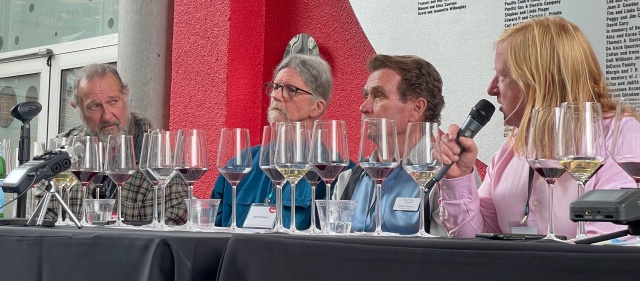
Then Locke said, “When I came to California, I worked for another winery in Santa Cruz called Bonny Doon Vineyard. I had a mentor in Randall Grahm. Barry, you worked with a lot of people. And a lot of people have worked for you and with you. Does this seem like a community here that has more of a sense of mentorship, cooperation, and community?”
Jackson answered, “I believe that there’s a sense of community, and sense of creating opportunities. If you create opportunities for others, you create opportunities for yourself. One of my favorite stories is how Jeff Emery went to work bottling wine one afternoon, and never left. And there are at least two wineries that have sprung from people that worked for Jeff.”
“I tried very hard to talk those people out of starting wineries,” said Emery to a roomful of laughter. “But they wouldn’t listen. Denis Hoey [Odonata Wines] was my assistant for 10 years. And he’s done great work. And Cole Thomas of Madson Wines, who’s here pouring today” now has his own winery and tasting room around the corner from Santa Cruz Mountain Vineyard on the Westside.
Locke asked Patterson a question similar to one he asked Theriot earlier. “When you’re standing at Mount Eden looking over to Ridge, is it important to you that the wines be more similar from year to year, or should they be more distinct from one another?”
Patterson replied: “Ridge Monte Bello is grown at a higher elevation [than Mount Eden], and it shows that. Mount Eden [pictured above in the title image] is a little more towards the ocean, a little more westerly, so It’s colder. Mount Eden, if you compare an estate Cabernet to a Monte Bello, Mount Eden wine is a little bit bigger because it’s grown in a little bit warmer spot. Something else that’s interesting: in the whole state of California, there’s hundreds and hundreds of Cabernet Sauvignons made. There’s only a couple that are made on a coastal mountain range at elevation: Mount Eden and Ridge, Bates Ranch vineyard is another example. In the whole state! So one thing I want to say, the thing about my place and a lot of Santa Cruz places, they were inspired by these European specifically French immigrants who were wine people. In Charles Sullivan’s wonderful book on the history of the Santa Cruz Mountains, ‘Like Modern Edens,’ Sullivan says there were three kinds of people in the 1800s in California that were in the wine business. First, there were true wine people, people who lived and breathed wine, and they often came from winemaking families. Second, there were farmers who might have grown prunes or apricots and decided to get into the grape business instead. And finally there were entrepreneurs, people that were business people that wanted to make money and saw that getting into the wine or grape business was one way of doing that.
“In the specific history of Mount Eden, there were two men that were so fundamental to our existence. One was Charles Le Franc, who had the Almaden Winery in the southern part of San Jose, and the other was Paul Masson. Paul was very unique. He came to California in 1880s. In the 1890s, he married the daughter of Charles Le Franc. Paul started his own winery, Paul Masson, which is now known as the Mountain Winery. It’s interesting, those two French people were wine people. They were business people for sure, but all they wanted to do their whole life was make wine. They were farmers, yes. But they were wine people number 1. And that’s really important. That’s what Santa Cruz Mountains is about. It’s about these European immigrants that came and planted these original vineyards. A long time ago, long before Napa and Sonoma were known for vineyards, Santa Cruz Mountains was THE place for top quality table wine.”
Locke noted to Bargetto, “You have this long history, multigenerational, and suddenly you decided ‘I’m gonna plant some Italian varieties here’.” Then he asked Bargetto why he made that decision, and why he decided to plant them at Regan where he is enjoying success with them.
Bargetto said, “We started Regan 30 years ago. The two no-brainer varietals were going to be Chardonnay and Pinot Noir. I knew I wanted to plant the Mount Eden clone, so we are beneficiaries of exactly what Jeffrey was talking about. Paul Masson brought the Mount Eden clone Chardonnay and Pinot Noir to our region [from cuttings from Burgundy]. So we are beneficiaries of that. I thought wouldn’t it be fun on this 50-acre piece to do something different to honor our Italian tradition. So we did Pinot Grigio for a white wine, and then I said why don’t we do some Northern Italian red varieties, that’s kind of to the heart of his question. So I said I’ve never grown Dolcetto, I’ve never seen a cluster of Dolcetto in my life, but it comes from our home town, Castelnuovo del Bosco in Piemonte, Italy. Dolcetto is famous in Italy as Dolcetto d’Alba and Dolcetto d’Asti, and I said we have to do Nebbiolo, the great red variety of Piemonte. It’s known to be a beast, I knew it would be high in acidity and high in tannin. In blending, we winemakers have a thought that there’s something magical about 3, plus you don’t know what’s going to do well. I came across Refosco at a UC Davis conference; good color, spicy, and it’s Italian, from the Veneto. So it’s been an adventure to pioneer and grow these varietals that really almost no one has in Santa Cruz Mountains or California.”
Then Foxx jumped in. “It’s so exciting to be able to try different varietals in the region. I have the good fortune that many of my clients let me experiment and put in test blocks and see what happens and how far I can push things. Christie Vineyard [owned by Storrs Winery] is in Corralitos, and Storrs Winery and Pam Storrs have been huge supporters of helping me work with these ridiculous varietals that I put in inappropriate places and produce wines out of them. The key with any varietal is can you get it ripe and will it not rot. Make sure there’s nothing wrong with it, and then you’re starting to get on the right road. But getting it ripe is so key. That’s really what makes a varietal work in any one place.”
Theriot then responded on the topic of ripeness. “As far as ripeness goes, people hear that and think sugar level, right? But what we are really talking about is phenological ripeness, so matching the acidity, the phenology, and the tannins, and really bringing all those things together in the best balance. That what it’s all about.”
Theriot continued, “For us, we have 150 acres to farm, which is a large parcel for the Santa Cruz Mountains, and it’s very difficult because the terrain is very steep.”
He then described some of the history of Ridge Monte Bello. “Our history goes back to the late 1800s. The four ranches that we farm on, totaling 150 acres, were all started in the late 1800s or early 1900s. Osea Perrone, who built the original facility in 1885 that we currently make wine in, was an Italian doctor from San Francisco. He shipped his wine up to San Francisco and called it the Monte Bello Wine Company. The next was John Torre, who was a cattle rancher, who bought 100 acres which is where our current tasting room is. It got sold to a theologian named William Short who worked it for about 10 years, then sold the property to the original Ridge founders, Hew Crane, David Bennion, Howard Ziedler, and Charlie Rosen, who bought that property in 1959, and rebonded it in 1962. Originally they were only going to sell the grapes. But David Bennion decided to make a half barrel out of it and realized it was very high quality, and that’s how the vineyards got started.
“One of the other two ranches that we farm is the Rousten Ranch. Charlie Rousten bought the property in the late 1800s. His son Charlie Jr. took it over in the late 1940s and he made wine. The lowest ranch that we farm [now called Jimsomare Ranch] ranges from 1400 to 2000’ and was originally called the Klein Ranch after an Alsatian man named Peter Klein who started planting vines in the late 1880s. He entered his Claret wine into the Paris Exhibition and won two gold medals, one for his Claret that they called the ‘Château Lafite of America’. There is such a history of winemaking in the Santa Cruz Mountains. It really was Prohibition that knocked the train off the rails within this industry locally. And now it’s exciting to see this industry take hold again and really dig in to making fine quality wines that we can be proud of, that are local, and we can enjoy and share.”
For the last question, possibly the most topical of the panel, Locke turned to Emery and asked, “Did the Santa Cruz Mountains AVA just come about from somebody just sitting around the table thinking it was a good idea, or was there actually some miles covered in determining where the outline of the appellation would lie?”
Emery replied, “The Santa Cruz Mountain AVA was formed by a group of folks who, starting in the mid to late 1970s, had wineries here and got together to really be able to pool resources. We were out in the boonies and getting stuff from Napa Valley cost a fortune. So the idea was Let’s all get together and pool our resources and do bigger buys of things we need. So we started having regular pot-lucks to just talk about how we made wine in the area, how to do things better. Through the course of that it was always coming back to ‘we have this unique place, the Santa Cruz Mountains. We should have an established name for the region.’ Napa Valley was already established, although I’d like to point out that Napa Valley is Napa County, the boundaries are arbitrary and political and don’t mean anything in terms of growing grapes. A number of the people we have been talking about—Dave Bennion, Ken Burnap, the Ahlgrens—thought it should be an AVA, but it should mean something. Previous to our AVA, the AVAs didn’t have boundaries based on how you were growing grapes. Two of the people that really got into it were Ken Burnap, who took every 8.5 minute quadrangle of the topography map for the entire region of the AVA and outlined in felt pen the 400’ line on the west side and the 800’ line on the east side, and David Bennion. Burnap and Bennion proceeded to go explore as much as they could. If there was a road that would cross that line, they would go around that. David Bennion was this wonderful person who always had an old leather satchel with no less than 2 bottles of wine and a crust of cheese in it at all times. They physically explored the entire AVA as part of the process of pitching it. They went to the US government, the BATF [Bureau of Alcohol, Tobacco, and Firearms] at the time, the people who approved that, and the BATF had in their code that an AVA had to meet certain criteria. Basically, Ken, the Bennions, the Ahlgrens, and all the people involved at the time said ‘we are going to do this and it’s going to mean something’. So they petitioned the US government to create the AVA, it was approved in 1981. It’s based on quality, geography, elevation, and climate.”
With that, the panel discussion concluded, although it was evident that the audience would have been happy for it to continue much longer. Such fascinating stories told by people who have lived this history and have such passion for our region!
Rootstock Wine Flight and Tasting Notes
Luckily, for those of us in attendance, we had an amazing flight of six stellar wines sitting in front of us, one from each of the wineries/vineyards represented on the panel. With the discussion done, it was time to focus on these special wines.

Here is a list of the flight along with links to the wines from producer websites:
2019 Equinox Winery Santa Cruz Mountains Blanc de Noir
2012 Santa Cruz Mountain Vineyard Vine Hill Vineyard Reserve Pinot Noir
2020 Bargetto Winery Regan Vineyard Reserve Pinot Noir
2019 Mount Eden Vineyards Estate Chardonnay
2004 Bates Ranch Vineyard Estate Cabernet Sauvignon
The Equinox sparkling wine was made from 100% Pinot Noir grapes. Aromas and flavors of apple skin, pear, white cherry, and yeast notes, this wine had medium-plus body and medium gold color with good persistent bubbles. According to Barry Jackson, he made this wine “very much like the first wine that Paul Masson gained notoriety with” in the Santa Cruz Mountains.
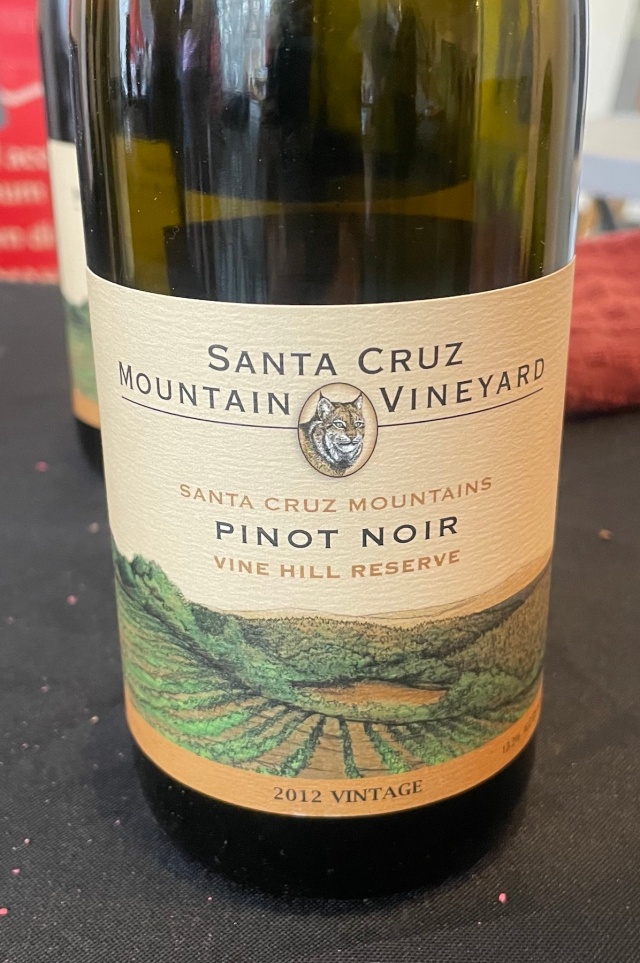
The Santa Cruz Mountain Vineyard Pinot Noir was a standout for me. At 10 years old, the wine was still very fresh and showed excellent balance between the fruit characteristics, tannin, body and acid. The lovely aromas were classic for Pinot Noir from the AVA, and Burgundy-like: dark cherry, forest floor, mushroom, wet stone, old roses, along with more tertiary notes like fig and dried cherry. Deep garnet in the glass, on the palate the wine had medium-plus acidity, medium tannin and alcohol, with a nice long chalky finish. The wine showed beautifully! Jeff Emery noted that “we are known for our Pinots living for decades.”
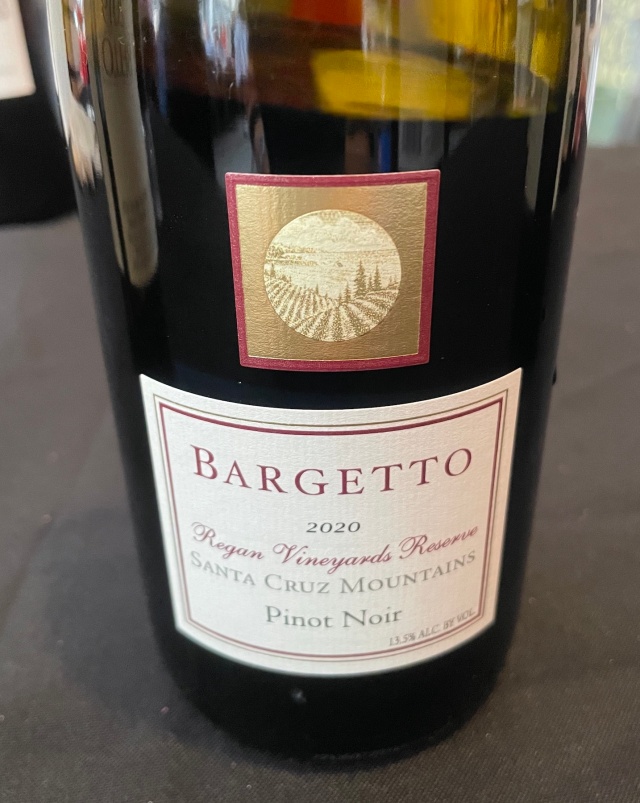
Next was the Bargetto Regan Pinot Noir, a young and bright red wine with a ruby color and silver rim. I have tasted this wine from previous vintages, and always enjoyed it. Unfortunately, for this particular vintage, on the nose and palate, smoke notes overpowered the fruit and left an ashtray-like sensation on the palate, leading me to conclude the wine was likely affected by smoke-taint. 2020 was a terrible year for winegrowing in the Santa Cruz Mountains due to the widespread CZU complex fires that erupted in August and burned for two months across the mountains. Although the Regan vineyard was not very close to areas that burned, there was a huge amount of smoke throughout the region for weeks. That fire and the destruction it brought to the area are part of the history of the Santa Cruz Mountains now.
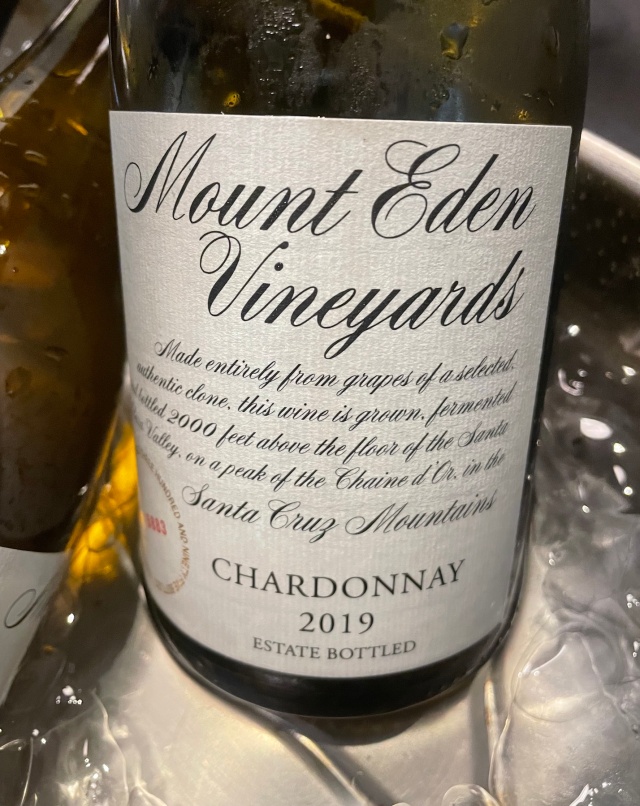
Moving on to the Mount Eden Chardonnay. Oh my goodness, this wine was amazing! From the famed Mount Eden clones at the famed Mount Eden Vineyard made by Jeff Patterson. Tasting like a ripe Meursault (one of the best French white Burgundy wines made from Chardonnay), this medium gold wine was lovely with aromas of mandarin oranges, evolved tropical notes (pineapple, mango), lemon curd, and hazelnut. On the palate, the medium-plus body was beautifully balanced by bright medium-plus acid with notes of caramel and butterscotch and minerality. Beautiful, clean, and full.
The next wine was something special also. Brought to the tasting by Prudy Foxx, this older wine showcased the wonderful terroir of Bates Ranch vineyard, renowned for its premium quality mountain Cabernet Sauvignon. At 18 years old, the wine was still so fresh, aging soundly, with the potential for years to go. The nose was just beautiful: blackberry kirsch, black currants (like cassis that has been open for a bit), mint, redwood duff, seaspray. Medium-plus acidity, medium alcohol and tannin, full body, with a lovely long finish. Clearly, Foxx succeeded at achieving the ripeness she was looking for with this wine.
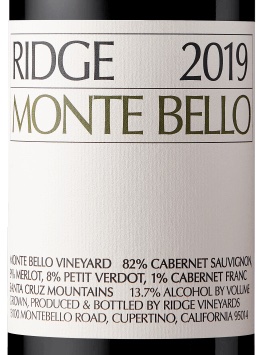
Last but not least was the 2019 Ridge Monte Bello. A classic Ridge Bordeaux-style red blend, this vintage consisted of 82% Cabernet Sauvignon, 9% Merlot, 8% Petit Verdot, 1% Cabernet Franc, all from the Ridge Monte Bello estate. In the glass, the wine was deep ruby with slow legs showing extracted color in them. The nose was complex and intense with notes of black cherry, meat, exotic spice, mint, dusty clay. On the palate, the wine was quite dry with medium-plus acidity, medium-plus tannin, medium alcohol, a great structure with a long chalky, fine-grain finish. Still showing youthful, this wine will age for 10 to 15 years easily. A fantastic example of the wine that came in fifth in the famous 1976 Judgement of Paris tasting!
Following the panel and grand tasting was a walk-around tasting throughout the museum where a dozen or so wineries poured their wines. My favorites from the walk-around tasting were:
- 2019 Aptos Vineyard “Opening Remarks” Pinot Noir from the DaLarDi vineyard. A lush, balanced Pinot Noir that gives you fruit up front, bring acidity, just a touch of oak, and a long finish.
- 1995 Storrs Winery Zinfandel – Wow! A Zin from Santa Cruz Mountains that was almost 30 years old! Super fun to taste this and it was showing very well with plenty of tertiary qualities (fig, raisin) and good acidity but also lower alcohol than a lot of Zinfandels we see now. Special treat!
- 2014 Equinox Winery Brut Ultra Santa Cruz Mountains Blanc de Blanc – I loved the acidity and freshness of this wine, which was made without an additional dosage (added sugar). Not only was it an excellent palate cleanser, it had body and complexity that allowed it to pair wonderfully with the charcuterie and cheeses being served at the event.
- 2019 Santa Cruz Mountain Vineyard Zayante Vineyard Syrah – A lush and full red wine from one of the most historic vineyards in the Santa Cruz Mountains, this wine was probably the boldest one I tasted at the event.
- 2017 US Grant Winery Union Vineyard Pinot Noir – I had not tasted wines from US Grant before and was blown away by the top quality here. Made with minimal intervention in open-top cement “tea cups,” this wine was one of the best Pinot Noirs I tasted. The quality of fruit from the Vine Hill area was showcased perfectly by the skilled winemaking techniques of winemaker Michael Terrien, who was pouring the wines and was gracious enough to answer my many questions during the event. Well worth it if you can find these wines!

Most of the wines mentioned in this article are available for purchase directly from the producers’ websites. You can also purchase these and other great local Santa Cruz wines at two wonderful local wine shops: Soif Wine Shop in Downtown Santa Cruz, and Deer Park Wine & Spirits in Aptos.
Excellent Resources on the History of Santa Cruz Mountains AVA
Websites
Some of the wineries in the Santa Cruz Mountains with lots of rich history have a plethora of historical information and timelines on their websites. Here are links to some of the best ones:
Santa Cruz Mountain Vineyard – Formation of the Santa Cruz Mountains AVA
Mount Eden Vineyards – Who We Are, History and Legacy
Ridge Vineyards website – History and Timeline
Beauregard website – Terroir: Santa Cruz Mountains AVA
Beauregard website – History and Ben Lomond Mountain sub-AVA
Also, two important organizations in the AVA are excellent for history and resource information about our region:
Santa Cruz Mountains Winegrowing Association website – Wines of Santa Cruz Mountains
Viticulture Association of the Santa Cruz Mountains website – About the Appellation
Books
A few of my favorite books on the history of Santa Cruz Mountains AVA:
Late Harvest: Wine History of the Santa Cruz Mountains, by Michael R. Holland, 1983.
Like Modern Edens: Winegrowing in the Santa Clara Valley and the Santa Cruz Mountains from 1798 to 1981, by Charles L. Sullivan, 1982.
Vineyards in the Sky: The Life of Legendary Vintner Martin Ray, by Eleanor Ray, 2006
An Ideal Wine: One Generation’s Pursuit of Perfection–and Profit–in California, by David Darlington, 2011.
Be sure to click the Follow button to follow my blog and get notified every time I publish a new post!
Title photo: Mount Eden Vineyard, courtesy Mount Eden Vineyards
Except as noted, all photos copyright © Laurie Love

Laurie DOES love wine!😀 The amount of detail and thoroughness included in your blog is quite impressive . YOU are impressive, sis!
Cheers from your sis🍷😘
LikeLike
Would love to send you some samples of what we’ve produced over the past 35 years here in the Santa Cruz mountains
LikeLike
Hi John, I’d be interested in tasting your wines. I haven’t tasted Hallcrest wines in several years, and I know there’s a lot of history there. Please send me your contact info through the Contact tab, and I’ll be in touch. Thank you for reading!
LikeLike
Wow Laurie! I just read this blog. The detail is great. What a panel. All the best of Santa Cruz for sure. Looks like fun and so interesting! Everyone forgets all about the historical prohibition and the effect it had on wine makers at the time.
LikeLike